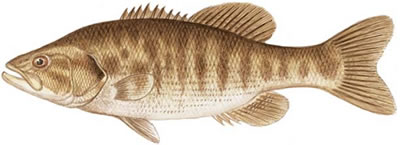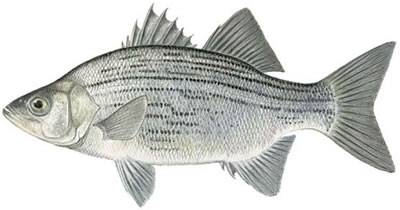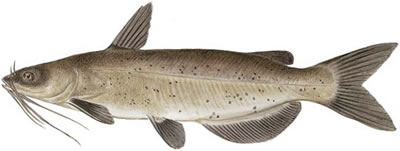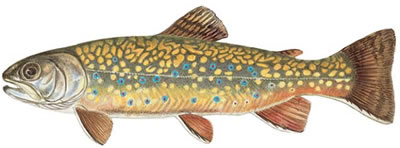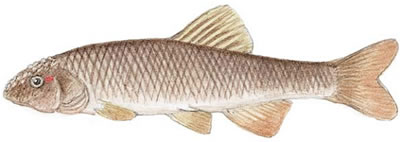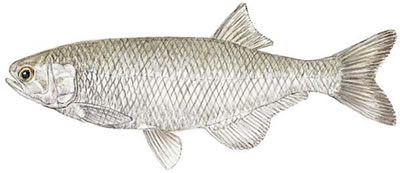Florida Largemouth Bass (Micropterus salmoides floridanus)
The Florida largemouth bass, also known as the Florida bass, is a subspecies of the largemouth bass, which in turn is often called a northern largemouth. This fish occurs naturally in Florida. Mixtures of it and northern largemouth are called intergrades, as they are neither pure Florida nor pure northern strains. These fish occur from northern Florida to Maryland.
Florida bass grow to trophy size more readily than do northern largemouth bass. They have been stocked in many states, including California, which has produced near–world record 22-pounders from transplanted stocks, and in Texas, which has completely transformed its big-bass potential by stocking this fish.
loading...
Guadalupe Bass (Micropterus punctulatus)
The Guadalupe bass is a member of the Centrarchidae family and is similar to the spotted bass (see: Bass, Spotted) in appearance. It has 10 to 12 dark bars along its sides, which are less distinct in older fish; it usually has 16 pectoral rays and 26 to 27 scales around the caudal peduncle. It can grow to almost 16 inches and usually weighs less than a pound. The all-tackle world record is a 3-pound, 11-ounce Texas fish taken in 1983.
In North America, Guadalupe bass are restricted to the Edwards Plateau in the Brazos, Colorado, Guadalupe, San Antonio, and upper Nueces (where introduced) River drainages in southern Texas. They occur in gravel riffles, runs, and flowing pools of creeks, as well as in small to medium rivers.
loading...
Largemouth Bass (Micropterus salmoides)
The largemouth bass is the biggest and most renowned member of the Centrarchidae family of sunfish and its subgroup known as black bass. It is sometimes confused with the smallmouth in places where both species occur, and also with the spotted bass (see: Bass, Spotted). One subspecies, the Florida largemouth bass (see: Bass, Florida Largemouth), M. salmoides floridanus, is capable of attaining large sizes in appropriate waters but is otherwise similar.
Identification
The largemouth bass has an elongated and robust shape compared to other members of the sunfish family. It has a distinctively large mouth, as the end of its maxillary (jaw) falls below or beyond the rear margin of the eye; the dorsal fin has a deep notch separating the spiny and soft rays; and the tail is broad and slightly forked.loading...
Peacock Bass
Peacock bass are among the world’s hardest-fighting freshwater fish. They willingly take lures, strike hard, and provide a strong and exciting battle.
The term “peacock bass” is a misnomer, but it is a name that has good marketing value and one that has stuck in the English-speaking world. Species that are called peacock bass in English are formally known as pavón in Spanish-speaking countries and as tucunaré in Brazil.
loading...
Redeye Bass (Micropterus coosae)
 |
| Redeye Bass (Micropterus coosae) |
There are two widely recognized forms of this member of the black bass group of the Centrarchidae family: the Apalachicola, which is called a shoal bass, and the Alabama, which is generally referred to as the redeye bass or the true redeye.
The shoal bass has yet to be described fully or given a distinct scientific name, and there is some confusion over the two. A scrappy fighter, the redeye bass often jumps when hooked and is hard to catch. Its white, flaky meat is of good table quality, similar to that of other black bass.
loading...
Roanoke Bass (Ambloplites cavifrons)
 |
| Roanoke Bass (Ambloplites cavifrons) |
The Roanoke bass is a sunfish and a member of the Centrarchidae family, similar in body shape to a rock bass (see: Bass, Rock) or warmouth (see). It can be identified by its unscaled or partly scaled cheek and the several iridescent gold to white spots on its upper side and head. It is olive to tan above, has a dark and light marbling on the sides, and often sports rows of black spots and a white to bronze breast and belly.
It is also distinguished by the 39 to 49 lateral scales, 11 anal rays, and 27 to 35 scale rows across its breast between the pectoral fins. The all-tackle world record is a 1-pound, 5-ounce fish taken in Virginia in 1991. Growing to a maximum of 14.5 inches, the Roanoke
loading...
Rock Bass (Ambloplites rupestris)
 |
| Rock Bass (Ambloplites rupestris) |
The rock bass is actually a member of the sunfish family and is not a true bass. Rock bass are fun to catch because they can be caught on many types of baits and lures, and they put up a decent fight on ultralight tackle. Rock bass are known to overpopulate small lakes, making population control measures necessary.
Identification
Although it looks like a cross between a bluegill and a black bass, the rock bass is actually a large and robust sunfish with a deep body; it is less compressed than most sunfish and is more similar to a black bass in shape. The back is raised, and the large head is narrow, rounded, and deep.loading...
Smallmouth Bass (Micropterus dolomieui)
The smallmouth bass is the second largest member of the Centrarchidae family of sunfish and a North American original. To anglers, it is one of the most impressive of all freshwater fish and is coveted for its fighting ability.
The smallmouth is not actually a bass but a sunfish, and its mouth is only small in comparison to that of some relatives. It is naturally a fish of both clear rivers and lakes and has been widely introduced to other waters outside its original range.
loading...
Spotted Bass (Micropterus punctulatus)
Often mistaken by anglers for the largemouth bass, the spotted bass is a lesser-known member of the black bass group of the Centrarchidae family than either the largemouth or the smallmouth, but this is a spunky and distinguished-looking species that no angler is unhappy about catching, even if most are encountered by accident.
The general term “spotted bass” really incorporates three recognized subspecies: the northern spotted bass (M. p. punctulatus), the Alabama spotted bass (M. p. henshalli), and the Wichita spotted bass (M. p. wichitae); the last was previously thought to be extinct and is still rarely encountered.
loading...
Suwannee Bass (Micropterus notius)
The Suwannee bass is similar in bodily appearance to the smallmouth bass and in markings to the redeye bass, except that it is generally brown overall, and the cheeks, breasts, and bellies of large males are bright turquoise.
It, too, has a large mouth, with the upper jaw extending under the eye, and possesses a patch of teeth on the tongue, a spot at the base of the tail, and blotches on the sides. It is further identified by its 59 to 64 lateral scales, 16 pectoral fin rays, 12 to 13 dorsal fin rays, and 10 to 11 anal fin rays.
loading...
White Bass (Morone chrysops)
A member of the temperate bass family, the white bass is a freshwater fish known for its spunky fighting ability, as well as its merits as an excellent eating fish. Because of its small size, it is often considered a panfish. White bass usually travel in schools and can provide a lot of action, making them highly desirable among light-tackle enthusiasts and for fishing with family and youths.
Identification
The white bass has a moderately deep and compressed body that is raised behind the small head and the large mouth, deepest between the two dorsal fins. It also has 11 to 13 rays on the anal fin and one to two patches of teeth at the back of the tongue. The coloration is mostly silvery with a dark grayish green on the back and anywhere from 4 to 10 dark horizontal stripes running along the sides. It also has yellow eyes, clear to dusky dorsal and caudal fins, and clear to white pectoral and pelvic fins.loading...
Whiterock Bass (Morone saxatilis x Morone chrysops)
Hybrid striped bass have become one of the most popular introduced fish in freshwater. Hybrid stripers are the progeny of one pure-strain striped bass parent and one purestrain white bass parent. When the cross is between the female striper and the male white bass, the result is primarily known as a whiterock bass; in some places it is referred to as a wiper and in some simply as a hybrid striped bass. When the cross is between the male striper and the female white bass, it is called a sunshine bass (primarily in Florida) or simply a hybrid striped bass.
These fish, which usually look like stockier versions of pure-strain stripers, are aggressive and hard-fighting fish that provide great sport. The fact that they are so strong and grow fairly large rather quickly endears them to anglers, not to mention that they can be a more ambitious lure and bait consumer than pure stripers.
loading...
Yellow Bass (Morone mississippiensis)
 |
A popular light-tackle quarry and usually lumped into the category of panfish, the yellow bass is a scrappy fighter and provides good sport on light tackle. With white, flaky flesh, it is also a good food fish, on a par with or exceeding white bass and compared by some to the yellow perch.
Many anglers are unfamiliar with this member of the temperate bass family because it is largely restricted to the middle portion of the United States and is smaller than its relatives; a true bass, the yellow is related to the striped bass, the white bass, and the white perch.
loading...
Bluegill (Lepomis macrochirus)
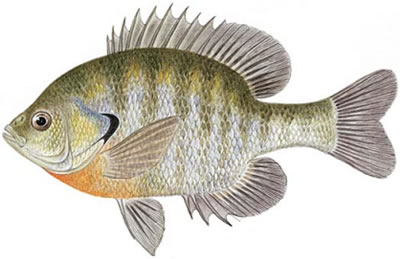 |
| Bluegill |
At times easily caught by novice and experienced anglers alike, bluegills are among the most popular panfish species in North America. This notoriety is the result of their vast distribution, spunky fight, and excellent taste.
Commonly referred to as “bream,” bluegills are the most widely distributed panfish and are found with, or in similar places as, such companion and related species as redbreast sunfish, green sunfish, pumpkinseeds, shellcrackers, and longear sunfish, all of which are similar in configuration but different in appearance.
loading...
Bowfin (Amia calva)
Described as a living fossil, the bowfin is the only existing member of the Amiidae family, a group of fish that originated in the Cretaceous period more than 100 million years ago. Of little commercial value because of their poor-tasting flesh, bowfin are excellent fighters and are caught by anglers wherever they are abundant, although mostly unintentionally.
When not abundant, they are a rare catch, and many anglers are unfamiliar with them. Although they are sometimes considered pests or nuisances by anglers seeking other quarry, bowfin are helpful in constraining otherwise large, stunted populations of smaller fish.
loading...
Bigmouth Buffalo (Ictiobus cyprinellus)
 |
| Bigmouth Buffalo |
A member of the Catostomidae family of suckers, the bigmouth buffalo is so called because of its humped back.
Identification
The robust and deep-bodied bigmouth buffalo has a large head with a big, distinctively oblique, and toothless mouth. This terminal, thin-lipped cavity angles downward when closed, although the edge of the upper lip is practically on a level with the eyes.loading...
Smallmouth Buffalo (Ictiobus bubalus)
 |
| Smallmouth Buffalo |
The smallmouth buffalo is second only to the bigmouth in the sucker family in terms of size and commercial importance, although it has a better reputation as a food fish than does its larger relative. The smallmouth buffalo, however, is less abundant and subsequently less commercially important.
Identification
A deep-bodied and compressed fish, the smallmouth buffalo has a small conical head, a high-arched back, and a long dorsal fin. It also has a small, thick-lipped mouth with distinct grooves on the upper lip; the upper jaw is considerably shorter than the snout.loading...
Black Bullhead (Ameiurus melas)
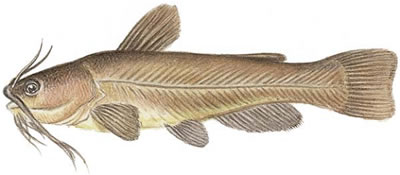 |
| Black Bullhead (Ameiurus melas) |
A smaller member of the catfish family, the black bullhead is very popular due primarily to its fine culinary appeal. It is often stocked in farm ponds and raised commercially.
Identification
Although the name would imply something else, the “black” bullhead may actually be yellowish green, dark green, olive, brown, or black on the back; bronze or green on the sides; and bright yellow or white on the belly. The entire body possesses a lustrous sheen. Only the young and spawning males are truly black.loading...
Brown Bullhead (Ameiurus nebulosus)
With its firm, pink flesh of excellent quality, the brown bullhead is an exceedingly popular species, sometimes included in the panfish category.
Identification
The head of the brown bullhead is large for its round and slender body, and the skin is smooth and entirely scaleless. The coloring of the brown bullhead is not always brown, but it may actually range from yellowish brown or chocolate brown to gray or olive with brown or black scattered spots; the belly is yellow or white.loading...
Yellow Bullhead (Ameiurus natalis)
Although the least commercially important of the catfish, the yellow bullhead can provide decent angling and is a good food fish.
Identification
A moderately slim fish, the yellow bullhead has leathery skin without scales. The coloring ranges from yellowish olive to brown or almost black on the back with yellowish olive or brown sides, yellow or white on the belly, and dusky fins. Juveniles are dark brown or jet-black.loading...
Burbot
The only freshwater member of the Gadidae family of codfish found in North America, Europe, and Asia, the burbot is often caught accidentally by anglers fishing for other species. Although it is a popular food fish in Europe, its ugly appearance makes it unappetizing to a fussy majority of Americans. It is mainly sold in salted form for ethnic consumption in North America but is also a source of oil and is processed into fishmeal; the liver is high in vitamins A and D and is sold smoked or canned in Europe.
Identification
The elongate shape of the burbot resembles an eel or a cross between an eel and a catfish. It has been mistaken for a catfish, and in some places it is called an eel, although it is neither. It also looks like a smaller and slimmer version of the saltwater cod.loading...
Common Carp (Cyprinus carpio)
 |
One of the largest members of the minnow family and a close relative of the goldfish, the common carp was also one of the first fish whose populations were regulated to increase production. Propagated for centuries and distributed widely, common carp are both beloved and despised. In North America, they are abundant but among the least favored targets of freshwater anglers.
Three varieties of common carp exist—the scaleless leather carp, the partially scaled mirror carp, and the fully scaled common carp, which is the most abundant of the three.
loading...
Grass Carp (Ctenopharyngodon idella)
A large member of the minnow family and an aquaculture species of worldwide importance, the grass carp is used for weed control because of its aggressive and herbivorous feeding habits. In the United States, where it was introduced in the early 1960s, it has become an extremely controversial species because of the biological damage it inflicts in the process of eliminating vegetation. This species is called the grass carp by critics, whereas supporters often refer to it as the white amur to avoid the negative connotations associated in North America with the name “carp.”
Identification
The grass carp has an elongate and fairly compressed body, a wide and blunt head, a very short snout without the barbels found on common carp, a short dorsal fin, and a moderately forked tail. The terminal and nonprotractile mouth has thin lips and sharp pharyngeal (throat) teeth especially suited to its feeding habits.loading...
Blue Catfish (Ictalurus furcatus)
This is a popular species within its range and prized for its flesh, as well as for its sporting value. The blue catfish is a strong, stubborn fighter. It can grow quite large, which enhances its appeal. It is considered good table fare and is widely pursued by commercial fishermen for the market. Its flesh is white, delicate, and tender, especially in smaller specimens.
Identification
Blue catfish are generally blue gray or slate blue and possess no spots or other markings, although they may be almost pale blue or silvery; their flanks taper in color to their bellies, which are light gray or white. They have deeply forked tails, and their anal fins have straight margins. They resemble channel catfish and when small are most easily confused with that relative.loading...
Channel Catfish (Ictalurus punctatus)
The most widely distributed of all freshwater catfish, the channel cat is a significant component of recreational angling efforts, as well as a mainstay of commercial fishing; its tender, white, and nutritious flesh is highly valued as table fare. It has been stocked widely in lakes and ponds, and provides the backbone of catfish farming activities.
In some states, the sporty channel cat is ranked at or near the top among all species in angling popularity. Channel catfish have the potential to attain large sizes, although less gargantuan than other species, but their general willingness to strike baits, their wide distribution, and their high food esteem primarily account for their popularity.
loading...
Flathead Catfish (Pylodictus olivaris)
A common and large-growing species, the flathead is one of the ugliest members of the freshwater catfish clan. Nevertheless, large specimens are commonly caught, and the fish provides a good struggle on hook and line. It is important for both commercial and recreational use and produces good table fare when taken from clean environments.
Identification
The flathead catfish is distinctive in appearance and not easily confused with any other species. It has a squared, rather than a forked, tail, with a long body and a large flattened head. Medium to large specimens are rather pot-bellied and have wide heads and beady eyes.loading...
White Catfish (Ameiurus catus)
White catfish are a common and popular fish with more limited range than other catfish species, and with commercial as well as recreational value. They have been successfully stocked in pay-to-fish ponds and are also cultivated for commercial bulk harvest. Their flesh is white and fine, and they make excellent eating, especially when caught from clean environments.
Identification
The white catfish looks somewhat like a cross between a channel cat (see: Catfish, Channel) and a bullhead (see), owing to its slightly forked tail, broad head, and squat body. Midsize specimens are often thought to be huge bullhead. The white catfish has a moderately forked tail, which distinguishes it from the flathead catfish and the bullhead, whose tails are not forked.loading...
Charr
The term “charr” (or “char”) is used to describe five members of the genus Salvelinus. They are members of the Salmonidae family, which also includes trout, salmon, whitefish, and grayling, all of which are endemic to the temperate and cool regions of the Northern Hemisphere but have been introduced widely outside their native range.
The charr group includes only one species that is actually called a “charr” in the English language, the arctic charr (Salvelinus alpinus), which is also referred to in some scientific texts as the S. alpinus complex, because in modern times it has come to represent many fish that were previously thought to be separate species or subspecies.
loading...
Arctic Charr (Salvelinus alpinus)
The arctic charr is one of five species that are actually classified as charr. It varies so greatly in coloration that many specimens are thought to be species or subspecies, resulting in a great deal of confusion and a tremendous problem for taxonomists.
This confusion extended to anadromous and nonanadromous forms, the latter including three New England charr—the blueback trout, the Sunapee trout, and the Quebec red trout, which were once separately recognized species but which were all reclassified and folded under the highly inclusive umbrella S. alpinus in 1974.
loading...
Creek Chub (Semotilus atromaculatus)
The creek chub is one of the largest chub and a member of the minnow, or Cyprinidae, family, making it a distant relative to carp. Occurring in great abundance in North America, it is important forage for sportfish, often competes with those larger predators for food, and, because it is hardy and lively, is also a prominent bait used by anglers.
Identification
The snout of the creek chub is pointed and its mouth large, with a single small barbel in the corner of each jaw, sometimes hidden between the maxillary and the premaxillary. The body is stout, colored olive brown on the back, silvery on the sides with shades of iridescent purple, and whitish on the underside.loading...
Hornyhead Chub (Nocomis biguttatus)
The hornyhead chub is a member of the large Cyprinidae family and a fairly common stream and river resident; smaller specimens are used as bait by anglers.
Identification
The body of a hornyhead chub is slender with a rounded snout. The mouth is large, almost terminal, with a small barbel above the jaws, and it has pharyngeal (throat) teeth. The hornyhead chub has dark-edged scales, a complete lateral line, and seven anal rays. Its coloring is bluish olive on the back, yellowish with iridescent green on the sides, and whitish on the underside.loading...
Chubsucker
Chubsuckers are members of the sucker family, Catostomidae. They are divided into three separate species: the creek chubsucker (Erimyzon sucetta), the lake chubsucker (Erimyzon oblongus), and the sharpfin chubsucker (Erimyzon tenuis). All species are extremely similar and are interchangeably referred to as “suckers” or “mullet” in different locales.
Chubsuckers are of little importance commercially and are predominant ignored for sportfishing. When taken from cold water, however, chubsuckers have good-flavored, firm flesh. Because of their abundance and their large size, chubsuckers often account for the greatest biomass in streams and lakes, making them important forage for predator species.
loading...
Cisco (Coregonus spp)
There are a number of similar species under the Coregonus genus, which is classified as a member of the Salmonidae family and generally acknowledged as a subfamily of whitefish. Whitefish and cisco inhabit many of the same waters and may be confused, although cisco are generally smaller.
One of the most common of these is Coregonus artedii, simply referred to as cisco. This species is often portrayed as the only cisco because the differences between species are only minor variations in body or snout shape, depth preference, or number of eggs. However, there are, or were, perhaps as many as 11 species of cisco, some of which were primarily very deep-dwelling fish.
loading...
Black Crappie (Pomoxis nigromaculatus)
Crappie are like that Chinese dog called a Shih Tzu. Most people don’t say the name of that dog in a way that sounds flattering. Ditto for the poor crappie. If its name were pronounced by more folks as if it contained the letter o instead of a, as in crop, we would all be better off.
No matter how you pronounce the name, both the black crappie and the white crappie are the most distinctive and largest members of the Centrarchidae family, which includes sunfish and black bass. Both species are considered excellent food fish and sportfish and have white, flaky meat that makes for sweet fillets. In many places crappie are plentiful, and creel limits are liberal, so it does no harm to keep a batch of these fish for the table.
loading...
White Crappie (Pomoxis annularus)
Members of the Centrarchidae family, which includes sunfish and black bass, white crappie are usually thought of in the same breath as black crappie. Both species are considered excellent food fish and sportfish and have white, flaky meat that makes for sweet fillets. In many places, crappie are plentiful, and creel limits are liberal, so it does no harm to keep a batch of these fish for the table.
Identification
The white crappie and the black crappie are essentially the same color, a silvery olive to bronze with dark spots, although the white crappie is somewhat paler; in the white crappie the spots are arranged in seven or eight vertical bands on its sides, whereas in the black crappie the spots are scattered.loading...
Blacknose Dace (Rhinichthys atratulus)
A member of the Cyprinidae family of minnows and carp, the blacknose dace makes excellent bait due to its small size and hardiness and, like many small minnows, provides excellent forage for predator fish, especially bass and trout. It is not sought by anglers but may be netted for use as bait.
Identification
The blacknose dace has a long slim body with a slightly protruding snout. The barbels, which are characteristic of most minnows, corner both sides of the mouth. The coloring is silvery, with dark olive gray fading to white on the belly. A dark lateral line runs along either side onto the head. It can be distinguished from the longnose dace (Rhinichthys cataractae) by its shorter snout.loading...
Longnose Dace (Rhinichthys cataractae)
A member of the Cyprinidae family of minnows and carp, the longnose dace has many valuable functions. Easily obtainable, small, and extremely hardy, it is prized as exceptional bait and is especially significant for bass fishing. Primarily feeding on blackfly larvae, it is also valued for its control of the blackfly population. And, like many small minnows, it provides excellent forage for predator fish, especially bass and trout. It is not sought by anglers but may be netted for use as bait.
Identification
The longnose dace is a distinctive minnow with a long fleshy snout, a subterminal mouth, and a deep caudal peduncle. The head and the nape slope downward from its cylindrical body, giving this minnow a streamlined appearance. Pigmentation is widely variable; the dorsum can be greenish, brown, or reddish purple, and the lower sides and the venter may be silvery, white, or yellow.loading...
Darters
Darters are an incredibly diverse and colorful group of freshwater fish, which rival saltwater fish in brilliance. They are actually small representatives of the perch family (Percidae) and are closely related to yellow perch and walleye. The darter group consists of approximately 160 species, all of which are restricted to North America. As such, they represent 20 percent of all fish in the United States.
Identification
Three genera of darters are recognized: Percina, which includes roughly 40 species; Etheostoma, which includes roughly 112 species; and Ammocrypta, with 7 species. The genus Percina contains the largest darters. Most are rather drab and cryptic in coloration, although the males of some species exhibit impressive spawning coloration.loading...
Freshwater Drum (Aplodinotus grunniens)
The freshwater drum is the only North American freshwater representative of the Sciaenidae family, which includes the croaker, the drum, the corbina, and the seatrout, among others. It also has the greatest range of any North American freshwater fish, is highly adaptable, and is an excellent battler on light tackle, although it is extremely underrated and underutilized as a sportfish.
A unique feature of the freshwater drum is its oversize otolith—a flat, egg-shaped “ear bone” used for hearing and balance. It is surrounded by fluid and has a white, enameled surface with alternating light and dark bands that can be used to determine the age of the fish. These are often kept as good luck charms or made into jewelry. Excavated from Indian village sites, huge otoliths from freshwater drum indicate that at one time the fish grew as large as 200 pounds.
loading...
American Eel
American eels are members of the Anguillidae family of freshwater eels and are preyed upon by many species at different stages of their existence. They are important forage for such large offshore predators as sharks, haddock, and swordfish; for inshore species like striped bass; and for many species of birds, including bald eagles and various gulls. Larger individuals (10 to 16 inches or so) are used as bait by anglers, especially those seeking big striped bass, and they may be sold as bait in coastal shops.
Identification
he body is elongate and snakelike, with a pointed head and many teeth. It is covered with thick mucus, hence the phrase “slippery as an eel.” The large mouth extends as far back as the midpoint of the eye or past it. There is a single gill opening just in front of the pectoral fins. There are no pelvic fins, and the soft-rayed dorsal, anal, and caudal fins form one continuous fin. There are no visible scales. Coloring changes with maturity, as described later in this text.loading...
Fallfish (Semotilus corporalis)
The fallfish is a member of the Cyprinidae family, the largest family of freshwater fish, which also includes minnows and carp. Often confused with the creek chub, the fallfish is the largest in its minnow clan.
Identification
The body of the fallfish is slender, with a bluntly pointed head. There is a single, long dorsal fin. On an adult, the scales are arranged in a pattern of dark, triangular black bars. The mouth is terminal and has barbels—which are characteristic of cyprinids—that are sometimes hidden.loading...
Alligator Gar (Lepisosteus spatula)
The alligator gar is the largest member of the gar family, Lepisosteidae, and one of North America’s largest inland fish. It is a primitive species, dating from the Mesozoic era, 65 to 230 million years ago. Fossil remains of gar are often found in limestone quarries throughout the southern United States. The tough, armorlike scales of this species were once used by Indians as arrowheads, and pioneer farmers covered their wooden plowshares with gar hides.
The gar is a resilient fish with an adaptable specialized air bladder that enables it to take in air at the surface, allowing it to survive in the poorest water conditions. Holding a strong resemblance to its namesake, the alligator gar is strong and voracious, and a tough fighter when hooked. It is capable of jumping spectacularly.
loading...
Florida Gar (Lepisosteus platyrhincus)
The Florida gar is a member of the Lepisosteidae family, an ancient group of predaceous fish once in abundance and widely distributed. Its specialized air bladder enables the gar to take in air at the surface, allowing it to survive in the poorest waters. Although edible, Florida gar are unpopular as food. They are caught by anglers, although not extensively pursued. The roe is highly toxic to humans, animals, and birds.
Identification
The body of the Florida gar is cigar-shaped, and it has a broad, tooth-filled snout. The single dorsal fin is located directly above the anal fin. Its tough scales form a bricklike pattern. Like the spotted gar, it has spots on top of the head, as well as over the entire body and on all the fins. These spots sometimes run together to form stripes.loading...
Longnose Gar (Lepisosteus osseus)
The longnose gar is the most common and widely distributed member of the gar family, Lepisosteidae, one of the few remaining ancient groups of predaceous fish once in abundance. Its long endurance is due to a specialized air bladder that enables the gar to take in air at the surface, allowing it to survive in the poorest waters.
Identification
The body of the longnose gar is long and slender. It has an extended narrow beak (18 to 20 times as long as it is wide at its narrowest point). The skeleton is part cartilage and part bone. Both upper and lower jaws are lined with strong, sharp teeth. The nostrils are located in a small, bulbous, fleshy growth at the very tip of the beak.loading...
Shortnose Gar (Lepisosteus platostomus)
The shortnose gar is the smallest member of an ancient family, Lepisosteidae, of predaceous fish. It is the most tolerant of all the gar, as it is capable of withstanding murky and brackish water with the help of its specialized air bladder. The bladder allows the gar to gulp in supplementary air and to release gases.
Because large numbers of coarse fish and panfish exist in many waters inhabited by gar, the shortnose gar (as well as other gar) can be useful in controlling these populations. In some areas, however, it is considered a nuisance by anglers and sometimes even a problem because of its abundance.
loading...
Spotted Gar (Lepisosteus oculatus)
The spotted gar is a member of an ancient family, Lepisosteidae, of predaceous fish. It is often confused with its close relative, the Florida gar. The spotted gar has good sporting virtues but is not widely pursued, and it is often caught incidental to other fishing activities. It is not considered a good food fish, and its roe is toxic to humans but not to other fish.
Identification
The body of the spotted gar is long and cylindrical, covered with hard, ganoid (diamond-shaped) scales. It has a single row of teeth in each jaw. The spotted and the Florida gar are the only two gar that have spots on the top of the head, as well as over the entire body and on the fins.loading...
Goldeye (Hiodon alosoides)
A member of the Hiodontidae family of mooneye, the goldeye is one of Canada’s most celebrated freshwater fish, from an epicurean viewpoint. Although often called a herring or a shad, it is neither. The goldeye provides good sport for light-tackle anglers, but it is not pursued in many parts of its range.
Identification
The goldeye is a small fish whose compressed body is deep in proportion to its length and is covered with large, loose scales. Dark blue to blue green over the back, it is silvery on the sides, tapering to white on the belly. It has a small head and a short, bluntly rounded snout with a small terminal mouth containing many sharp teeth on the jaws and the tongue.loading...
Arctic Grayling (Thymallus arcticus)
Grayling belong to the Salmonidae family and are related to trout and whitefish. They are distinctive-looking fish, with a sail-like dorsal fin, and are a superb sportfish known primarily in the cool- and coldwater northern regions of North America. Their firm, white flesh is good table fare, although it is not on a par with that of the wild trout and the charr that inhabit similar ranges. Grayling are excellent when smoked, however.
Identification
With its graceful lines, large fin, and dramatic coloration, the grayling is a striking fish. Most striking is its large purple to black dorsal fin, which extends backward and fans out into a trailing lobe, speckled with rows of spots. This fin may look bluish when the fish is in the water. Grayish silver overall, grayling usually have shades or highlights of gold, lavender, or both, as well as many dark spots that may be shaped like an X or a V on some fish.loading...
Northern Hogsucker
This is a widespread and distinctive-looking member of the sucker family.
Identification
The northern hogsucker gets its name from its piglike appearance, particularly its head. It has a very steep forehead and long, protruding lips, bearing a strong likeness to a pig’s snout. Its head also has a concave depression between the eyes, a trait distinctive among suckers. The body is conical, with the head region much thicker than the caudal peduncle. The body is marked with four lateral bars that come together on the fish’s back to form saddles. The northern hogsucker is generally darkly pigmented on the back and lightly pigmented on the belly.loading...
Inconnu (Stenodus leucichthys)
A member of the Salmonidae family and a relative of whitefish and cisco, the inconnu is a species with limited northern range. The only predatory member of the whitefish group in North America, it is highly favored by anglers as an exciting and large sportfish, but it is perhaps the least caught of North American gamefish. Its silvery coloring and tendency to leap high out of the water when hooked have earned it the nickname “Eskimo tarpon.”
Identification
The general body shape of the inconnu is very similar to that of a charr or a whitefish, but the head is relatively long, pointed, and depressed on the top. Its mouth is large, and the lower jaw clearly projects outward beyond the upper jaw. The maxillary, or upper jaw bone, extends back at least as far as the middle of the eye.loading...
Subscribe to:
Comments (Atom)

